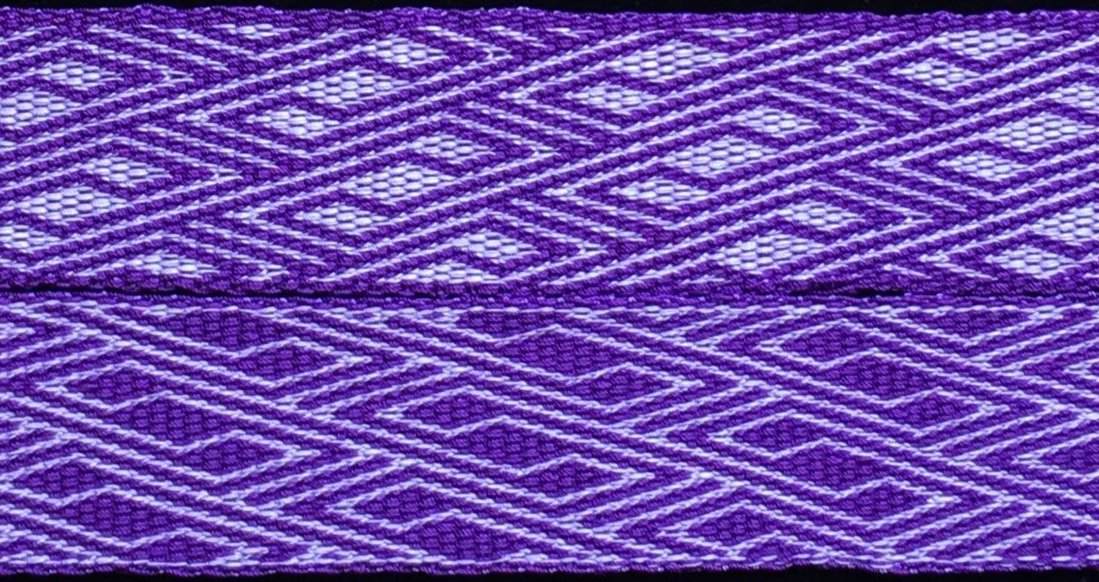Explorations in Tablet Weaving
I weave to stretch my mind and nourish my soul.
If my mind, hands, and looms also create something beautiful and useful, my efforts are more than rewarded.
Tablet weaving has nourished my soul ever since the early 70s when I first learned of its existence “… during a workshop on two totally unrelated subjects: rugs and loom-controlled garments. As if that were not enough for a new weaver to digest in three days, on the second day, almost as an afterthought, the workshop leader pulled out a deck of cards and had us trim them into squares, punch holes in the four corners, and warp them with cheap yarn, according to a simple, threaded-in pattern. Soon we were turning the tablets and, almost miraculously, that awful warp turned into a wonderfully patterned band.” Marilyn Emerson Holtzer, Interview with a TWIST Founder, TWIST, 8 (Spring 2012). OK, the warp was still awful.
In the mid 70s, I began experimenting with six-hole tablets and worked out the details for weaving diagonals, two-threads wide, in three colors, a technique I dubbed “Diagonal Triple-Turn.” I described this and another technique that I developed for creating double-woven and double-faced bands using six-hole tablets in two articles published in 1980 (Fiber Publications 2 and 4). Recently, I have been experimenting with eight-hole tablets and two-hole tablets. I’ve learned that greater is sometimes less and fewer is sometimes more.
Diagonal Triple-turn Tablet Weaving.
Diagonal Triple Turn Tablet Weaving. Diagonals need not be two threads wide; these are just one thread wide and were woven using six-hole tablets with six different colors of thread.
Double Weave and Double-faced Tablet Woven Krokbragd on Six-hole Tablets.

Pieces of Eight: Diagonals

Pieces of Eight: Diagonals and Such. Four-color diagonals, each two threads wide, can be woven using four packs of four-hole tablets, or more easily using two packs of eight-hole tablets.

Pieces of Eight: advancing twill sequences in silk.

Eight-hole Tablets and some "Pieces of Eight". The tablets on the left and center were hand cut from greeting cards and those on the far right were custom made from heavier stock by Christopher Poor.

This seemingly repetitive (original) tablet weaving pattern repeats exactly only after 376 turns.

Diagonals woven using two-hole tablets. Silk and Tenntrad (TM).

Threaded-in pattern woven using Two-hole Tablets. This "deconstructed" four-hole pattern, yields a band just two layers thick so that the threads always lie on one of the faces and never hidden between.

De-constructed, threaded-in, four-hole pattern woven using two-hole tablets. Tencel (TM) with warp beading

Warp ends of a tablet-woven band: Polychrome ribbon and fine threads.

A few silk bands I wove while hospitalized with leukemia. Patterns and variations were later published in Fiber Art Reference 16.

Tablet-woven Band of Polychrome Ribbon and Fine Threads. Tablets with fine threads were turned more frequently than tablets with ribbon.
TURNED BOUND WEAVE
NORWEGIAN WEAVE

Tablet Woven Band with Norwegian pattern

Tablet Woven Band, detail.
WEFT BROCADED BANDS
Brocade samples. Various wefts; kumihimo-silk warps, two threads per tablet. Second pattern from left is original. Click photo for references to tablet woven brocade and most other patterns.
Brocade sample. Embroidery floss (cotton) weft; 5/2 perle cotton warp, two threads per tablet.
Brocade sample. Embroidery floss (cotton) weft; 5/2 perle cotton warp, two threads per tablet.
Brocade sample. Glass bead weft; Tencel(TM) warp. Two threads per tablet. Click photo for references to tablet woven brocade.
Brocade sample. Glass bead weft; Tencel(TM) warp. Two-threads per tablet.













